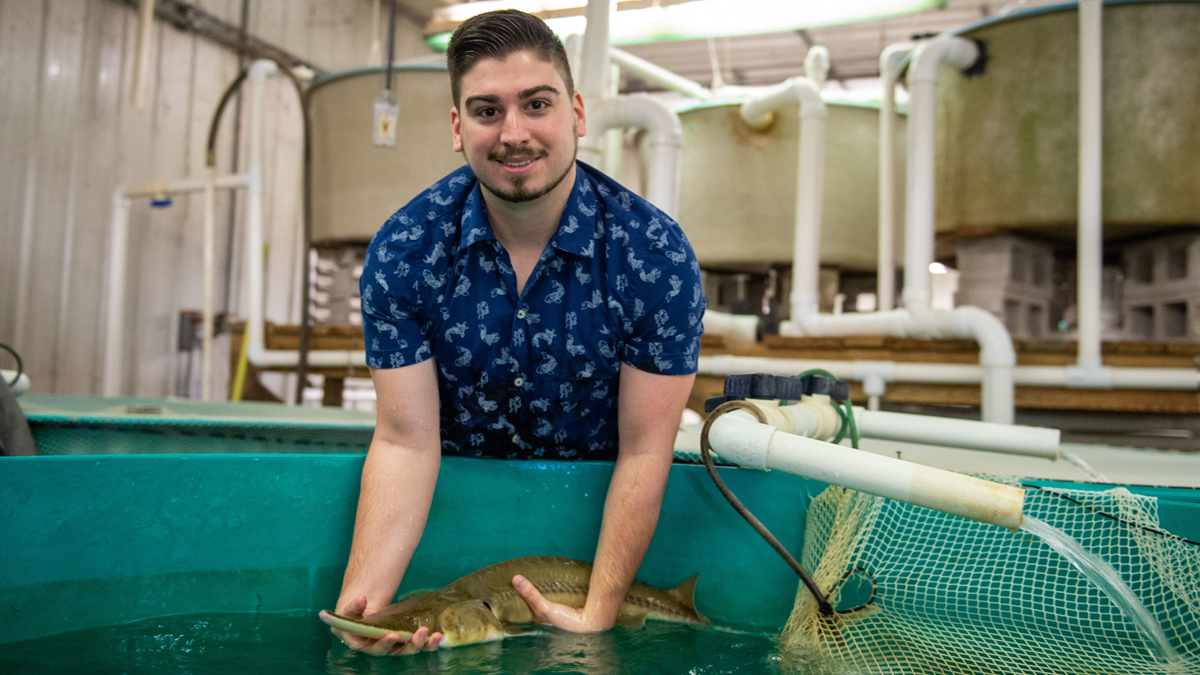
Richard Flamio, a doctoral student at Southern Illinois University Carbondale, holds a rare pallid sturgeon at one of SIU’s fishery labs. Flamio recently worked with scientists from the U.S. Geological Survey to manipulate the DNA of the endangered fish in order to improve conservation tactics to save it. (Photo by Russell Bailey)
April 08, 2021
SIU doctoral student studies endangered pallid sturgeon DNA to save it
CARBONDALE, Ill. — A doctoral student at Southern Illinois University Carbondale recently helped federal scientists manipulate the DNA of an endangered fish in order to improve conservation tactics to save it.
Richard Flamio, a research assistant at SIU’s Center for Fisheries, Aquaculture and Aquatic Sciences, worked with researchers at U.S. Geological Survey’s Columbia Environmental Research Center to produce offspring of federally endangered pallid sturgeon with DNA from only a single parent. Researchers hope the work might lead to developing new genetic markers that make it easier to distinguish between pallid sturgeon and the more common but closely related and nearly indistinguishable shovelnose sturgeon.
The results were posted in a paper at ScienceDirect.com.
An ancient species, endangered
With its fierce, bony appearance betraying its prehistoric roots, sturgeon are one of the oldest living species on the planet, with ancestors appearing in the fossil record dating back to the time of dinosaurs. Its presence in North American rivers and around the world has made a great impact on human culture. It is also prized for its eggs – caviar – to the point of being overfished in most of the world.
Ever since overseas beluga sturgeon populations crashed, prompting the United States to restrict caviar imports, demand for Mississippi River shovelnose sturgeon eggs has soared. A mature female can yield about a half-pound of eggs, which in turn can fetch prices of $300 an ounce, creating a strong incentive for those whose livelihoods depend on bringing the delicacy to market.
Pallid sturgeon, in particular, were listed by the federal government as endangered in 1990. But they often are mistakenly taken by fishers, because of their close resemblance to their coveted shovelnose cousins.
A complex scientific riddle
In its native habitat of the Mississippi and Missouri River basins, pallid sturgeon are now a rare species, so scientists say there’s no time to lose. But unraveling the pallid sturgeon’s genetics is even more difficult than usual.
To start, millions of years of evolution has equipped the species with twice as many paired chromosomes as most others. Further complicating the issue is the fact that pallids breed with shovelnose, creating a hybrid that is able to reproduce. These hybrids are not endangered.
The complexities mean existing genetic markers cannot always indicate the difference among pure pallid sturgeon, shovelnose and the hybrid. This challenges genetic studies, but that’s where Flamio helped bring a novel strategy to fruition: Working at SIU’s labs, Flamio helped create many more – hundreds of thousands more – genetic markers for the fish, which will give scientists the specific information they need to make that critical distinction.
SIU’s track record draws collaboration
Researchers like Ed Heist and James Garvey at SIU’s Center for Fisheries, Aquaculture and Aquatic Sciences have been engaged in monitoring and finding mitigation strategies aimed at arresting the problem for 15 years or more. The SIU Conservation Genomics Laboratory has been working on several projects for many years with USGS, Flamio said.
“We are one of the primary laboratories in the country working on conservation genetics of the endangered pallid sturgeon,” he said.
Hacking the system
In this effort, scientists used deactivated sperm from distantly related male paddlefish, and eggs from a female pallid sturgeon, to successfully create pallid sturgeon embryos that carry the genetics of only the female parent. Flamio traveled off-site to assist in this process and then, under the direction of Heist, conducted all genetic analyses at the SIU Conservation Genomics Laboratory at Life Science III.
“This involved isolating DNA from the samples and testing the samples for sturgeon and paddlefish genetic markers,” Flamio said. “This is an innovative method for developing genetic tools for organisms, such as the pallid sturgeon, with unusually large genomes.”
The work Flamio is doing is in support of his doctoral research. He currently is using the offspring – called haploid individuals – to continue finding better genetic markers that will differentiate pallid from shovelnose. He also is building a genetic linkage map, that will provide a “blueprint” of the sturgeon’s DNA including genes that are spatially mapped into individual chromosomes.
